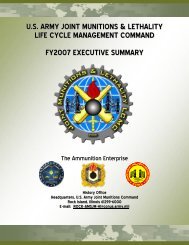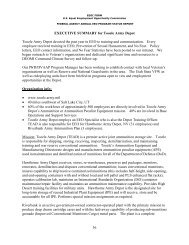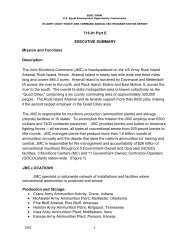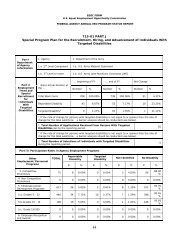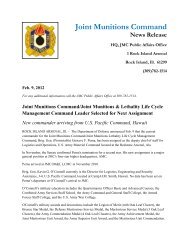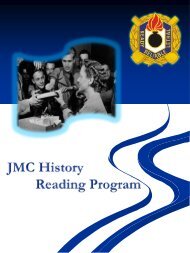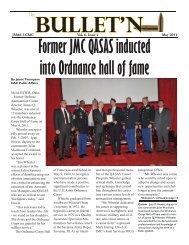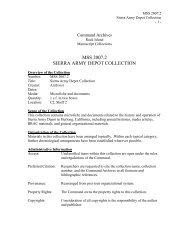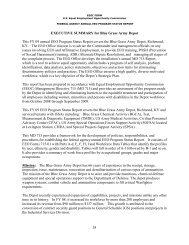History of the Ammunition Industrial Base - JMC - U.S. Army
History of the Ammunition Industrial Base - JMC - U.S. Army
History of the Ammunition Industrial Base - JMC - U.S. Army
Create successful ePaper yourself
Turn your PDF publications into a flip-book with our unique Google optimized e-Paper software.
AMCCOM found ano<strong>the</strong>r seven items would reach full rate sustainability within one to three<br />
months and an additional 12 items could reach <strong>the</strong> sustainment level in four to six months.<br />
Forty-three items would not be fully sustainable for a whole year. In several instances, items<br />
falling into <strong>the</strong> one year category represented ammunition which had been previously dropped<br />
from production due to budget cuts. 165<br />
AMCCOM created an ammunition base priority listing for recommended strategic<br />
facility actions in order to bring more items into full rate sustainability. The highest priority was<br />
for increasing domestic base capability <strong>of</strong> 25mm tungsten penetrators by purchasing special<br />
tooling and equipment. Commercial producer, Aerojet was reactivated for <strong>the</strong> production <strong>of</strong><br />
30mm-GAU-8 ammunition and Line 8 at Holston AAP reactivated production <strong>of</strong> Mine Clearing<br />
Line Charges (MICLIC) components. Production <strong>of</strong> TNT was accelerated at Radford <strong>Army</strong><br />
<strong>Ammunition</strong> Plant (RFAAP) as well.<br />
O<strong>the</strong>r ammunition production plants accelerated schedules to meet sustainable rates but<br />
this method <strong>of</strong> meeting <strong>the</strong> requirements had drawbacks. If an AAP‟s schedule was compressed<br />
so that <strong>the</strong> production <strong>of</strong> a twelve month supply was met in a matter <strong>of</strong> six months, <strong>the</strong> plant was<br />
entirely ahead <strong>of</strong> production at <strong>the</strong> end <strong>of</strong> six months and <strong>the</strong>n needed ano<strong>the</strong>r six months to a<br />
year to handle <strong>the</strong> long lead time needed to start production again. Only one additional<br />
production line had to be opened for <strong>the</strong> sustainment <strong>of</strong> ODS which was mentioned above - <strong>the</strong><br />
25mm line.<br />
Many <strong>of</strong> <strong>the</strong> problems associated with ammunition during Operation Desert Storm were<br />
logistical in nature due to <strong>the</strong> large quantities <strong>of</strong> ammunition shipped to support ODS. Large<br />
movements in transit turned out to be <strong>of</strong> limited value when President George Bush declared <strong>the</strong><br />
war over shortly after it had started. It was estimated that soldiers in <strong>the</strong> field had ammunition<br />
available to <strong>the</strong>m at a rate <strong>of</strong> 180 to 250 percent beyond <strong>the</strong>ir actual needs. 166<br />
Reduction <strong>of</strong> <strong>the</strong> <strong>Base</strong> – <strong>Base</strong> Realignment and Closure (BRAC)<br />
BASE Realignment and Closure (BRAC) is <strong>the</strong> process used by <strong>the</strong> United States<br />
Department <strong>of</strong> Defense (DoD) and Congress to close excess military installations and realign <strong>the</strong><br />
total asset inventory in order to save money on operations and maintenance. More than 350<br />
installations have been closed in four BRAC rounds: 1989, 1991, 1993 and 1995. The most<br />
recent round <strong>of</strong> BRAC completed in <strong>the</strong> fall <strong>of</strong> 2005 and with <strong>the</strong> commission's<br />
recommendations became law in November <strong>of</strong> 2005.<br />
In 1988 <strong>the</strong> Secretary <strong>of</strong> Defense chartered <strong>the</strong> Commission on <strong>Base</strong> Realignment and<br />
Closure (BRAC) to review military installations within <strong>the</strong> U.S. for realignment and closure.<br />
One way to uncover and release funding was to realign, move, and close <strong>Army</strong> bases and<br />
installations. For <strong>the</strong> Armament Munitions and Chemical Command (AMCCOM) this meant <strong>the</strong><br />
closure <strong>of</strong> idle facilities and plants that had not operated since Vietnam. Reevaluation <strong>of</strong> <strong>the</strong><br />
military strategy and decrease in <strong>the</strong> size <strong>of</strong> forces drove <strong>the</strong> decision to reduce Defense<br />
infrastructure.<br />
165 Porter & Lepore, 168-170.<br />
166 Porter & Lepore, 170.<br />
54



